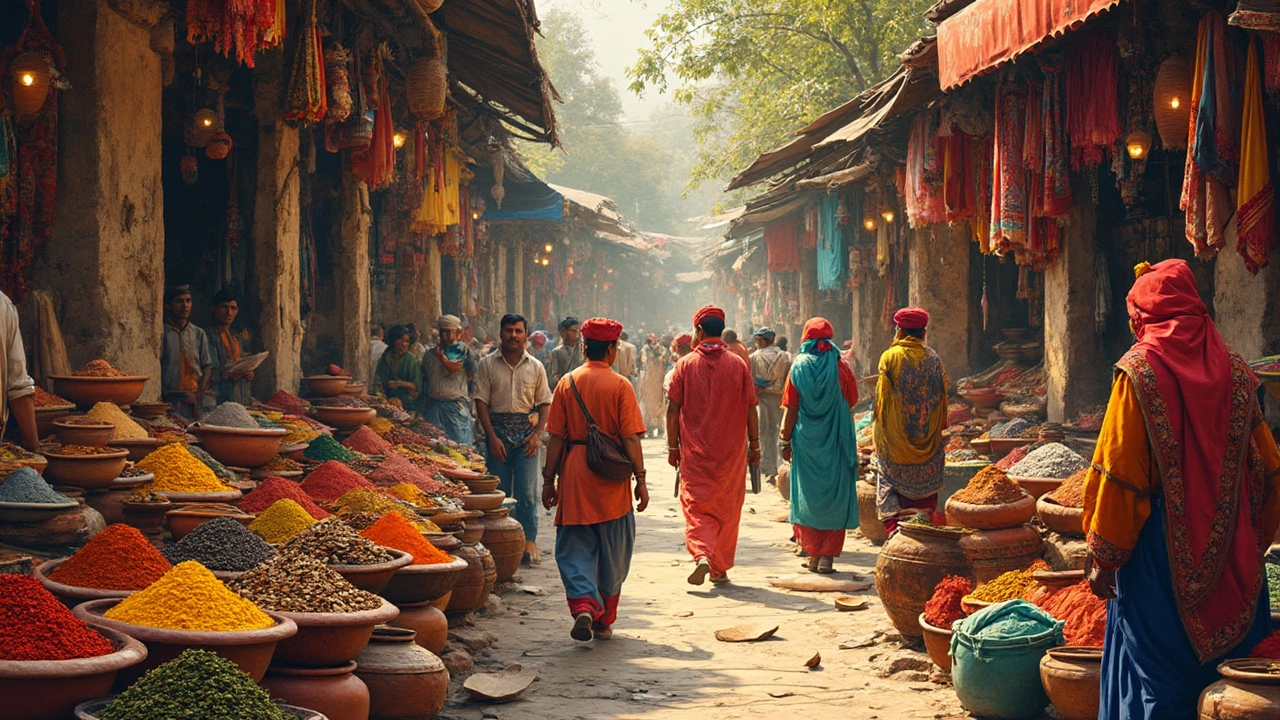
India has long been a hub of vibrant trade, with its bustling markets and diverse industries. So, what exactly does India specialize in when it comes to international trade?
Let's start with textiles and garments. This sector is a backbone of Indian exports, thanks to its rich heritage in fabrics and design. You'll find everything from cotton sarees to intricate silk pieces making their way to global markets.
Then there's the booming information technology and software services industry. You know those tech help desks that solve your computer woes? Many of them are based right here. India's IT services are recognized worldwide for their quality and innovation.
Pharmaceuticals are another area where India shines. Known as the pharmacy of the world, India produces affordable generic drugs that are exported to various countries, contributing significantly to global healthcare.
And let's not forget agriculture. With a climate that supports diverse crops, India exports a range of agricultural products, including spices that add flavor to kitchens worldwide.
Curious about diving into these industries? Trade courses in India offer great opportunities to learn the ropes and develop skills crucial for a career in these sectors. You can gain insights into market trends, negotiation tactics, and much more. Who knows, you might just become the next big thing in India's trade scene!
Textiles and Garments
When it comes to India trade, textiles and garments are a cornerstone. India is one of the world's largest producers of textiles and garments, and this industry employs millions across the country. The diversity and quality of materials—ranging from cotton and silk to jute—make Indian textiles a hot commodity globally.
The Rich Legacy
India's textile tradition dates back thousands of years, with references in ancient texts and artifacts. Today, this legacy continues as we blend traditional craftsmanship with modern techniques. Indian fabrics are celebrated for their intricate designs and vibrant colors, making them a mainstay in fashion capitals around the world.
"The textile sector contributes 2% to India's GDP and holds a whopping 13% of the country's export earnings," according to the Ministry of Textiles.
Modern Revival
So what's new? The industry is not stuck in the past. It's embracing technology for both production and sustainable practices. Innovations like digital printing and eco-friendly dyes are more common, aligning with global trends towards responsible consumption.
- Bangladesh, the US, and European Union are major markets.
- Export figures are constantly rising, thanks to strong demand for high-quality fabrics.
- The government supports industry growth with various policies and schemes.
Learning the Craft
For those looking to tap into this lucrative field, trade courses offer a pathway. They cover everything from fabric technology to fashion marketing, preparing you to make a mark in exports or start your own Indian economy success story.
In short, India's textile sector isn't just about textiles—it's about rich history, innovation, and endless opportunities. Whether you're buying or learning, there's no better time to dive into the world of Indian textiles and garments.
Information Technology and Software
India has become synonymous with Information Technology and Software services on a global scale. This industry has transformed from a low-cost outsourcing destination to a powerhouse of innovation and quality service. It's not just about call centers anymore. Indian IT companies are developing cutting-edge solutions for businesses worldwide.
One of the pillars of this success is the country's tech-savvy workforce. With a massive pool of skilled engineers and IT professionals, India consistently meets the demands of the rapidly evolving tech sector. The Indian Institutes of Technology (IITs) and other prestigious universities continually churn out graduates who are ready to tackle tech challenges head-on.
Major Players
Some of the key players in the Indian IT scene include TCS, Infosys, Wipro, and HCL Technologies. These companies are not just household names in India but are also recognized worldwide. They provide a range of services, from consulting and application development to infrastructure management and data analytics.
Contributions to the Economy
The IT sector contributes significantly to the Indian economy, both in terms of GDP and employment. It employs millions and plays a crucial role in urban centers like Bangalore, often dubbed as the 'Silicon Valley of India'.
| Year | IT Revenue (in Billion USD) |
|---|---|
| 2022 | 194 |
| 2023 | 210 |
| 2024 | 225 |
Challenges and Opportunities
While India's IT industry has seen explosive growth, it still faces challenges such as data privacy concerns and the need for constant innovation to remain competitive in the global market. However, these challenges bring opportunities in cybersecurity, AI, and cloud computing. With evolving digital needs, India is poised to keep its competitive edge.
Interested in jumping into this dynamic field? There are many trade courses in India focusing on IT skills, offering pathways to careers in software development, cybersecurity, and data science. With the right training and skills, you could be part of India's next big tech success story!

Pharmaceuticals
India is affectionately dubbed the "pharmacy of the world," and for good reason. The pharmaceutical industry here isn't just big; it's a global player. In fact, India ranks third in the world for pharmaceutical production by volume. When it comes to affordability and accessibility, Indian exports stand out on the international stage.
The Power of Generics
One of India's biggest strengths is its ability to produce high-quality generic drugs at a fraction of the cost of their branded counterparts. These generics have made healthcare accessible to millions around the world, especially in developing countries. Ever taken a generic aspirin or antihypertensive? There's a good chance it originally came from an Indian company.
Innovation and R&D
But it's not just about generics. India is ramping up its research and development (R&D). From developing new vaccines to inventing advanced drug forms, Indian firms are leaving their mark. Companies like Dr. Reddy's Laboratories and Cipla are household names in the pharma world now. They not only manufacture drugs but are also involved in cutting-edge research.
Export Statistics
Get a load of these numbers. In the financial year 2021-2022, India's pharmaceutical exports crossed a whopping $24 billion. That's a lot of medicine making its way to various corners of the globe, addressing ailments and saving lives. The industry's continued growth is a testament to its central role in global healthcare.
Challenges and Opportunities
Of course, like any industry, there are challenges. Regulatory hurdles, intellectual property issues, and price controls are ongoing concerns. However, the potential for growth still outweighs these hurdles. With initiatives to boost trade courses focusing on pharma, there's a real chance for budding professionals to make an impact.
| Year | Pharmaceutical Exports (in billion USD) |
|---|---|
| 2020 | 20.6 |
| 2021 | 22.4 |
| 2022 | 24 |
So, if you're interested in getting involved in this dynamic sector, consider diving into educational resources and trade courses that focus on pharmaceuticals. Whether it's research, manufacturing, or business strategy, the sector offers diverse career paths brimming with opportunities.
Agricultural Commodities
India's diverse climate and vast landscapes contribute to its reputation as a global powerhouse in agricultural commodities. It's not just about feeding its massive population; India plays a crucial role in global supplies, exporting a wide array of agricultural products far and wide.
Spices: The Flavor Masters
When it comes to spices, India is often the first place that comes to mind. From turmeric to black pepper, the country's spice production and export is unmatched. These aromatic wonders not only enhance flavor but also boost the country's cultural footprint around the world.
Rice: The Staple Export
India is the largest exporter of rice, particularly basmati rice, famous for its unique aroma and long grains. This is a staple food grain that finds its way to dinner tables across continents. People from Europe to Africa enjoy Indian rice for its quality and taste.
Tea: The Brew That Travels
Tea from India, particularly from regions like Assam and Darjeeling, is renowned globally. The tea industry is not just about sipping morning chai but an essential part of India's agricultural export economy. The taste and quality keep international markets coming back for more.
Did you know that in 2023, India exported over 2.6 million metric tons of rice? That's enough to fill stadiums!
Boosting Prospects with Trade Courses
Want to dive deep into the world of agricultural exports? Trade courses in India offer a great way to learn about the supply chain, market trends, and export regulations. These courses equip you to navigate the dynamic world of agriculture with ease.
The agricultural sector doesn't just provide business opportunities. It's a way to connect cultures and feed the world. Getting the right knowledge can place you at the heart of this critical trade puzzle.

